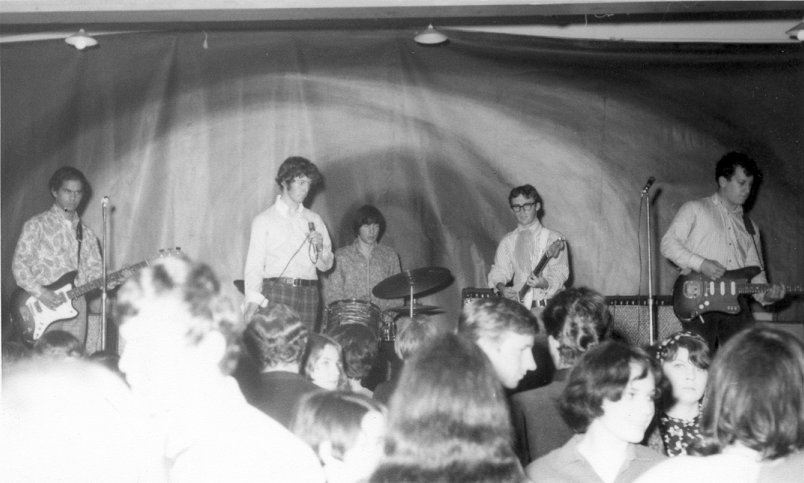
1966: L to R Laurie Opai, Rex Smith, Dan McCarthy, John Neath and Whymond Opai.
Green and Yellow

1966: L to R Laurie Opai, Rex Smith, Dan McCarthy, John Neath and Whymond Opai.
Line-Up:
Rex Smith (Vocals)
Gerry Sword (Lead Guitar)
John Neath (Rhythm Guitar)
Lawrence Opai (Bass Guitar)
Richard Goodman (Drums)
The Green and Yellow were another in the long list of Auckland bands who played the city club circuit in the late sixties, but never got to put any of their sound onto record. The group was formed in 1965, with most of the members coming from a previous South Auckland band, the Persuaders. The Green and Yellow name, selected by Rex, came from the liner notes of the first Byrds album.
The music was modeled mainly on the Shadows, and the "newer" pop groups of the day, such as the Beatles, Yardbirds, Kinks, and Manfred Mann. The band was managed by Tony Bryington, who was very crucial to the group, and he also filled the role of roadie and general good guy, arranging gigs, looking after the boys and supplying transport for all, as well as their gear, in his Humber 80.
The first real public outing was at the Irish Hall in Ponsonby, Auckland on New Year's Eve 1965. As 1965 turned into 1966, the world was awakened to the sounds of the Green and Yellow.
The first change to the line-up came when Gerry Sword left and formed a trio with two female singers, called the Newfolk. He was replaced by Lawrence Opai's brother, Whymond, who was later known as Motz. The music at this stage was still covers, but was moving more towards rhythm and blues.
Next to leave the group was Richard. He left to pursue his career as a butcher. He was replaced by Dan McCarthy. This change had a profound effect on the group. At Dan's audition, John noticed that Dan's syncopated rhythms blended marvelously with Lawrence's funky bass style. John was able to add a very chunky style of rhythm guitar to the mix, which gave an overall very tight driving sound. And this was just the audition.
He was hired and this became the new direction of the Green and Yellow. Many tunes were rearranged to incorporate this style. "A Land Of 1000 Dances" was one such modification, which was a much slower and soulful version than the popular Wilson Picket version. It was this line-up with Whymond and Dan that started to get them noticed.
The music was becoming funkier and more R&B influenced. One song that sort of became a signature tune at that time was a number put out by Lee Dorsey called "Ride Your Pony".
The main venues that the Green and Yellow played at were the Outram Hall in Murray's Bay on Auckland's North Shore, (a venue often shared with the Hi-Revving Tongues), the Masonic Lodge in Thames on the Coromandel Peninsular, the Papatoetoe Town Hall in South Auckland, plus many youth groups scattered throughout Auckland at the time (mainly on Sunday nights). The occasions were nearly always teen dances and socials. There were appearances at the Galaxy and Embers nightclubs as well as out of town appearances in Whangarei, Morrinsville, Rotorua and Taupo.
By this time the group was gaining some reputation and following. They were still primarily a covers band and included current hits from groups like the Easybeats and local bands, Larry's Rebels and the La De Da's.
In August 1967 the Green and Yellow entered the Battle Of The Bands and were lucky enough to win. Second place went to the Hi-Revving Tongues and third to the Radars. There was much controversy over the win as the band were told they had won and that the finals would be in Wellington. This was the first mention of the competition being a nation-wide event, and the band believed that the prize, a recording deal, should have been theirs. This not being the case, they did not go any further. The promoter was changed and the eventual national winner was the Fourmyula, with the Hi-Revving Tongues representing Auckland.
As the music was moving on and progressing in 1968, the group discussed the option of adding a keyboard to the line-up. John contemplated moving to keyboards as he had played piano in his earlier days. He believed that this would have given the group more versatility having either a second guitar or organ as required. But in the end he was reluctant to move and eventually left the band.
Lawrence Opai left to join the Smoke, and was replaced by Jon-Paul Gregory. When John Neath left, he was replaced by Rob Patient. Mal Logan was added to the line-up to play organ, while Peter Grattan, who had been with the Clan in Whangarei in 1966 and St Ludwig Group in 1967, before joining Marble Arch, replaced Dan McCarthy.
Peter left the group in late 1968 and rejoined the Clan, but was back with Green and Yellow by 1969. Jon-Paul Gregory left, to be replaced by Paul Collecut. The band didn't stay together for long after that.
Peter Grattan was later to rejoin Marble Arch, who now went by the name Arch and then Freedom Express. Mal Logan went on to replace Terry Rouse in Larry's Rebels. John Neath decided to concentrate on his career in telecommunications, which he is still involved with today.
The Green and Yellow did not officially record and release any material or appear on television. They did have a recording session with Jimmy Sloggett as a trial and a session at the NZBC Radio Theatre in Durham Street Auckland, but these did not result in anything being released. One of the problems was that the Green and Yellow did not write or have any original material.